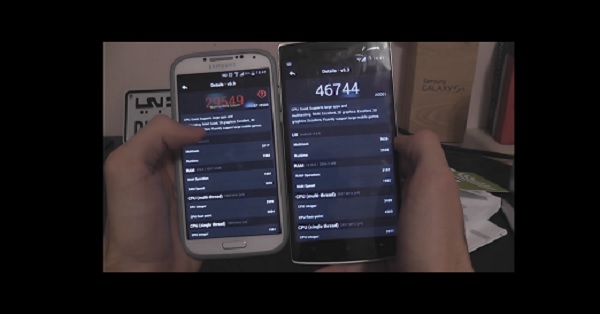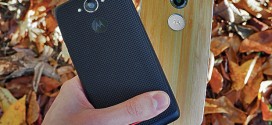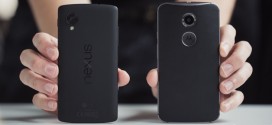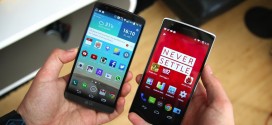The Samsung Galaxy S4 and the OnePlus One are two pretty hyped devices even after a decent amount of time has passed since their launch. The Galaxy S4 is actually said to be a better buy than the Galaxy S5, although it doesn’t come with as many high-end specs and features. The OnePlus One is referred to as a flagship killer because it comes with specs that can rival with phones like the Galaxy S5, HTC One M8 and Galaxy Note 3, all the while having a really affordable price between $300 and #350, depending on the storage option you choose to get. We are wondering whether the Galaxy S4, more than a year after its launch, can rival with the OnePlus One, one of the most popular devices of the year.
The Samsung Galaxy S4 and the OnePlus One have some things in common, but they do differ in crucial aspects. Most notable of all would be in software, as the Galaxy S4 comes with TouchWiz over Android 5.0 Lollipop, while the OnePlus One comes with CyanogenMod over Android 4.4.4 KitKat, but you can upgrade to CyanogenMod 12S. A great many smartphone enthusiasts would choose CyanogenMod over TouchWiz because it allows for much more customization and it runs smoother than TouchWiz. That can be considered a downside of the Galaxy S4. Let’s see how these two flagships compare in terms of design, specs and prices so that we can make an educated choice as to which is the better investment for the average smartphone user who doesn’t need the latest releases.
Design and Display
The Galaxy S4 design isn’t the best you can find on a smartphone because it comes with a plastic chassis which has faux chrome finish on its frame. The frame will look awful after a few weeks of use, because the chrome chips off leaving the plastic below barren and unaesthetic. The phone otherwise feels a bit cheap in the hand because the light weight of the phone isn’t really reflective of a premium quality. The Galaxy S4 weighs about 130 grams, which is pretty light for a phone. At the same time, from the front it looks pretty neat because it’s got thin bezels on all sides, which are rather attractive.
The OnePlus One comes with a soft-touch plastic back and a rather heavy weight of 162 grams, and it feels better in the hand than the Galaxy S4 does. Even though it comes with a plastic chassis, it seems sturdier than its competitor. The soft-touch material is much more nice to the touch than the shiny plastic on the Galaxy S4 and allows for a good grip. At the same time, the bezels on the sides and “forehead” are about as thin as they are on the Galaxy S4, but the bottom bezel is a bit thicker. The phone’s footprint is 152.9 x 75.9 x 8.9 mm, which makes it bulkier than the Galaxy S4 which measures 136.6 x 69.8 x 7.9 mm. The squared off edges of the OnePlus One look and feel a bit better than the Galaxy S4’s rounded corners, but that’s more up to preference rather than aesthetics.
When it comes to display, both these phones hold up nicely to newer flagships. The Galaxy S4 comes with a 5 inch Super AMOLED panel which has a 1080*1920 resolution that adds up to about 441 ppi pixel density. The Super AMOLED panel combined with the high pixel density makes for a rather nice viewing experience, with great outdoor viewing angles, decent color accuracy and outdoor visibility. Corning Gorilla Glass 3 protects the display from scratches and it does a good job, although the plastic construction of the device will allow the screen to crack pretty easily.
The OnePlus One display is a lot bigger, as it is a 5.5 inch LTPS LCD panel, with a 1080*1920 resolution that adds up to 401 ppi pixel density. The display quality is just a bit inferior to that of the Galaxy S4, as the Super AMOLED panel on the Samsung flagship is brighter and crisper, with better viewing angles and outdoor visibility. Still, the larger display on the OnePlus One is a bit more handy for those of us who love big displays. I for one prefer phablets, just because of the larger screen real estate, so I would definitely say the OnePlus One wins in this department. Still, the display quality is overall better on the Galaxy S4. The OnePlus One screen is also protected by Corning Gorilla Glass 3, but the phone’s body seems sturdier and more well-built, which isn’t as prone to letting the screen crack at the first drop.
Hardware and Camera
Samsung packed the Galaxy S4 with decent specs which were high-end at the time it was launched in April 2013. Those specs and hardware hold up pretty nicely nowadays, too, even though they seem a bit inferior. The Galaxy S4 specs include a Qualcomm Snapdragon 600 CPU clocked at 1.9 GHz, backed by 2 GB RAm and either 16 or 32 GB RAM with an added microSD card slot. Performance is pretty ok on the Galaxy S4, but most people who have used the phone for a while think that TouchWiz is a setback and makes the phone sluggish and unresponsive at times. That translates into an average performance, but it can hold up for the average smartphone user who doesn’t use too many heavy applications.
The OnePlus One fares much better in this department, mostly because it is a more recent release, as its launch date was April 2014, a year later than the Galaxy S4 release date. The Chinese smartphone comes with a Snapdragon 801 CPU clocked at 2.5 GHz, backed by 3 GB RAM and available in either 16 or 64 GB storage versions. You don’t get a microSD card slot on the OnePlus One, which is a drawback compared to the Galaxy S4. But if we think about it, there’s always cloud storage when it comes to media, so it’s not necessarily a deal-breaker. Since the OnePlus One is customizable and CyanogenMod 12s runs pretty well, performance is nearly spotless, although you do get the occasional lag when it comes to animations between homescreens, apps and so on. In-game or in-app, the OnePlus One handles most anything you throw at it better than the Galaxy S4 does.
Samsung tries to put good cameras in their devices, and the Galaxy S4 isn’t an exception. You get a 13 MP camera on the rear with an LED flash and autofocus, which can record 1080p video at 30fps, and it does a decent job. The front camera measures only 2 MP, but that’s enough for the occasional selfie here and there. The OnePlus One comes with the same camera, but it does have a larger front camera measuring 5 MP. Its camera performs similarly well, but both these phones lack a little optical image optimization. You can check out a camera comparison between these two phones in the video below, but be sure to lower the volume a bit before hitting play.
Price and conclusion
The OnePlus One became famous because of its very affordable price, as the 16 GB version costs $300, while the the 64 GB version costs $350. You can buy the OnePlus One from the company on every Tuesday of the week without an invite, but if you get your hands on an invite, you can buy it anytime you want to. You do need to pay attention, though because the company doesn’t deliver to every country around the world. The Galaxy S4 costs $340 unlocked if you want 16 GB internal storage, but if you want 32 GB you’ll have to pay around $380.
With these prices in mind, we can easily determine which of these former flagships is the better buy. Clearly, the OnePlus One offers much more for even less of a price. If you want a future-proof device that can give you all the average smartphone user needs, the OnePlus One is your best bet. If the company doesn’t deliver to your country, be sure to find someone who would send it to you and have it delivered to them. Good luck!
 Load the Game Video Games, Reviews, Game News, Game Reviews & Game Video Trailers
Load the Game Video Games, Reviews, Game News, Game Reviews & Game Video Trailers



